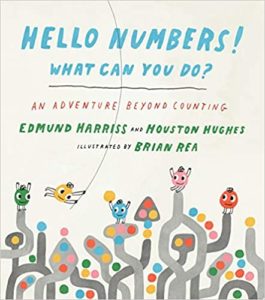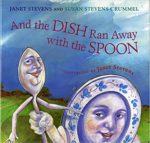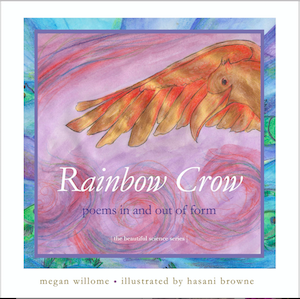Mindfulness and Mathematics
Dr. Edmund Harriss, a mathematician at the University of Arkansas, begins each class of the new semester with a mindfulness exercise.
“In his classes he does a meditation on the first day. He has the students close their eyes and slowly count up and visualize each number. He asks them to try and hold a mental picture of those things in their mind because visualizing numbers helps in math,” said poet and author Houston Hughes.
Hughes and Harriss worked together to create Hello Numbers! What Can You Do? An Adventure Beyond Counting, published last year. The book begins not with the number One, but with Zero and an invitation to mindfulness.
Can you think of nothing? Can you calm your brain
Till it’s still like a canvas just waiting for paint?
Just the sound of your breath and the beat of your heart—
This is the best way for counting to start.
Harriss discovered a fractal curve that now bears his name, the Harriss spiral. The spiral, which is created by the mathematical process of subdividing rectangles, is lovely. It’s not surprising, then, that Harris has published two children’s mathematical coloring books.
“I learned it’s far easier to persuade people who like coloring more than mathematics to take an interest in a mathematical coloring book, than to get mathematicians to take a coloring book seriously,” Harriss said.
So when Harriss and Hughes connected at a math-science-poetry event at the Crystal Bridges Museum of American Art, a picture book was bound to result.
I am one of those people who has always been intimidated by math. But reading Hello Numbers! showed me that math is a bit like poetry. It has rules but not rigidity. If, for example, we know how a sonnet works, then we can play with the form. If we know that the number Two always has a friend along, then we get a sense of a line and all that suggests, whether Two and its friend are close together or far apart.
Mathematics and Play
For Harriss, play is key.
“Mathematical play doesn’t require you to have any mathematical knowledge,” he said. “My general philosophy is that there’s very little you can throw at someone in the first five years of life that’s harder than just existence. It’s good to throw subtle and sophisticated ideas at children and see what gets developed. The notion that you shouldn’t confuse them is somewhat ridiculous because so much of their world is already confusing, things that we take for granted.”
As soon as Harriss and Hughes began to collaborate, their ideas gelled.
“Lightning just struck my brain. I went home, sat down, and banged out pages and pages,” Hughes said. “Edmund and I work great together because he’s an expert in his field, and I’m someone who loves to take high-level concepts and turn them into writing or videos or performances that the average person can engage with.”
From the beginning the book was child-focused. The only stretch words are vocabulary-based geometric words, like trapezoid and pyramid. While writing, Hughes would read a section to a 5-year-old and have her draw a picture of what was being described. If it matched the concept, then he knew they were on the right track.
“The book has a you-focus on a child,” Hughes said. “It’s geared toward empowerment, toward creation. It’s your own creative toolbox.”
Originally the plan was to count to Ten. But that would have put the book over the standard 32-page limit for picture books. Harriss and Hughes settled on Five. That allowed enough room to touch on arithmetic, geometry, and other concepts “beyond counting.”
Visualizing Numbers
The illustrations of internationally acclaimed artist Brian Rea are key to bringing mathematical concepts to life.
“The point of the words is to get readers to visualize numbers. Illustrations are a way to do it, but we don’t want to hand them too much visually,” Hughes said. “You’re supposed to go off and play with these numbers.”
What does that look like? Like a five-pointed star, reaching across the page fold, with two happy colored dots on one page and three on the other, each zooming in its own space pod.
Imagine with me that your five-pointed star
Has suddenly stretched out incredibly far,
With One, Two, and Three going all the way right,
While Four and Five head left with all of their might…
Hughes, who has spent most of his career as a performance poet, can’t wait to zoom left and right himself, all over the country, once book tours can safely resume.
“Writing and performing for kids overlaps in a number of ways — keep your writing to the point and keep your performances exciting and engaging. Plus any time you perform at a library or public event for kids, there’s another important bit of the audience to pay attention to: their parents,” Hughes said. “In that sense it’s just another poetry slam.”
Next Month’s Selection
Time to dust off your nursey rhyme knowledge! Join us on Friday, March 12, as we read And the Dish Ran Away with the Spoon by Janet Stevens and Susan Stevens Crummel, illustrated by Janet Stevens.
Photo by Marco Nürnberger, Creative Commons, via Flickr. Post by Megan Willome.
Browse more Children’s Book Clubs
“Megan Willome has captured the essence of crow in this delightful children’s collection. Not only do the poems introduce the reader to the unusual habits and nature of this bird, but also different forms of poetry as well.”
—Michelle Ortega, poet and children’s speech pathologist
- Perspective: The Two, The Only: Calvin and Hobbes - December 16, 2022
- Children’s Book Club: A Very Haunted Christmas - December 9, 2022
- By Heart: ‘The night is darkening round me’ by Emily Brontë - December 2, 2022




L.L. Barkat says
This is wonderful, Megan. Very intriguing!
I looked up the spiral. So cool. And I love their mutual approach to math. (And I wish I’d had this book for my kids when they were little. 🙂 )
Megan Willome says
I wish I had it when I was little!
Bethany R. says
What thoughtful fun! I’ll have to show this to my husband (a math guy). 😉
Megan Willome says
Bethany, I’d be interested to hear an opinion from a math guy alongside a non-math person. I am definitely the latter, but I found the book helped me connect several concepts.